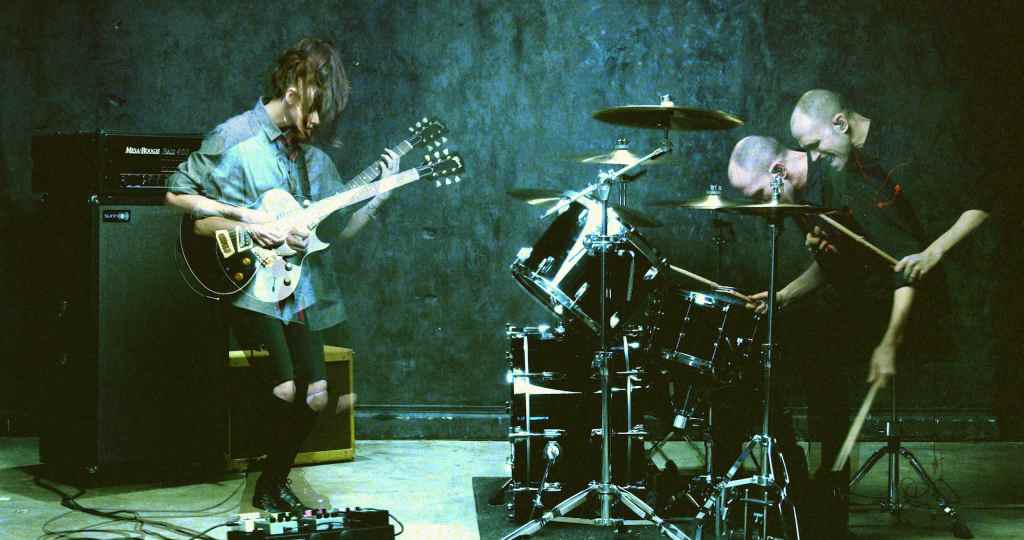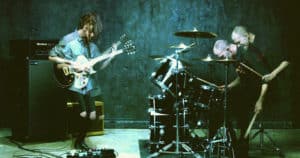Jerry Roe of Friendship Commanders on Recording at Home


Even before the pandemic shuttered most of the commercial studios for band sessions, Jerry Roe decided the new Friendship Commanders EP would benefit from being recorded at home.
“We wanted a thicker, more lush, and much grander sound than what we went for on our previous release, Bill,” explains Roe. “So we recorded everything at home with the exception of guitars—they’re simply way too loud—and it was a slightly terrifying, but ultimately rewarding experience. We tracked separately, and I took my time getting takes that I was happy with.”
The new EP, Hold On To Yourself [Trimming The Shield Records], was released this month, and it documents a new sound for the Nashville duo, in which Roe handles drums and bass, and Buick Audra sings and plays guitar.
“These songs called for me to slow it down a bit,” says Roe, “and to be a little more referential to the song and the mood, rather than the fierceness and attitude that we’ve gone for in the past. They’re still super hard to play, and they require a lot of bombast and intent, but more reverence to the structure and melody is required. I played without a click track—as we’ve done with all our previous releases—but these songs really benefitted from an elastic meter. For example, on ‘The Enemy I Know,’ I uniformly drop the chorus about 4bpm every time we get to it. The way the beat and the melody changes, the song really needed the extra space to breathe—not just to open up for the big release of the chorus, but also so that Buick’s voice could soar above the instrumental mix.” Advertisement
WATCH “THE ENEMY I KNOW”
What drum kit did you play while tracking the new EP?
I used a 1982 Tama Superstar birch kit with a 24×14 kick with Remo PS3 heads, a 15×11 rack tom, and a 18×16 floor tom—both with Remo clear Emperor heads. My snare was a stainless-steel Keplinger 8×14. Cymbals were all Meinl Byzance Traditional—15″ medium hi-hats, 18″ crash, 20″ crash, 22″ crash, and a 23″ heavy ride.
How did you mic the kit?
For my own home setup, I typically run about 12 or 13 mics. But Kurt Ballou of GodCity Studio in Salem, Massachusetts, mixed the EP, and he wanted top and bottom mics on the toms, so I added those. For the kick drum, I used an AKG D112 inside the shell and about an inch from the head, aimed directly at where the beater hits the head. I was going for a classic heavy-metal, super-impactful, bright, and heavy sound—which is basically what is required to cut through the intense death wall of Buick’s guitars. On the outside, I used a Sololon LoFReQ sub microphone.
For the snare, I used a Gronelli Audio Labs modified, right-angle Shure SM57, and I positioned it about an inch-and-a-half in from the rim, aiming at the center of the head at a 45-degree angle. There’s no other mic I like on snare—it just works. On the bottom, I used an Electro-Voice N/D 468, aiming straight up at the drum, and about two inches away from the head. Advertisement
On the toms, I used Josephson E22S mics for the batter side, about one or one-and-a-half inches in on the drum, and tilted upwards slightly to catch more attack. These are my favorite tom mics. They have a very crisp attack, but they also catch a great amount of low end. Cymbal bleed in the tom mics sounds great and is easy to manage. To mic the bottom of the toms as Kurt requested, I used Michael-Joly-modded Oktava MK-012 mics. Usually, I don’t mic the bottom heads, but it really does add some great rumble and intensity to the tom sound, and any phase cancellation you get from the close proximity of the mics is actually quite useful.
The overheads were two sE Electronics RN17 mics positioned at the same height, and aiming directly down at the cymbals on the far sides of the kit. I like how wide this makes the stereo image. The RN17s are silky mics that have all the aggressiveness of a small-diaphragm condenser, but are largely mellowed by the Rupert-Neve-designed transformers build into them.
On the hi-hat, I used an AKG C451 placed three inches directly above the cymbals, and aimed outwards towards the cymbal edges at 45 degrees to get more of a chunk sound. I miked the ride cymbal at the request of Kurt, and for that, I used an Electro-Voice N/D 468 that was placed underneath the ride aiming upwards. It sounded surprisingly good. Advertisement
For the room sound, I used an AEA R88 ribbon mic. It catches a lot of midrange, without getting too nuts in the high- or low-end frequencies. I placed the R88 six feet away from the kit, and two feet to the left of center, aimed directly at the snare drum. That’s the place where a room mic sounds best in my room.
Did the acoustic environment in your home present any issues with getting the sounds you wanted?
There were no real problems. Our recording room is untreated, and it has a cathedral ceiling, so it’s very live. Cymbals can get a bit loud, but not too crazy. I tend to play to the room to compensate—to the degree that I can when I’m playing this kind of music.
Typically, do you capture the drums without EQ and let your mixer adjust frequencies to suit the mix, or do you like to tweak EQ while recording?
Let’s say it’s “mostly” flat. There are EQ boosts on the inside kick track, the top snare track, and the toms—usually at 3kHz. I also boosted some low frequencies to suit each drum, and I cut some nasty low mids. Advertisement
How did you deal with noise isolation—or do you have groovy neighbors?
We didn’t deal with it at all! Thankfully, we have groovy neighbors. But that’s not a major surprise considering that we live in Nashville.
What were the killer apps in your studio process?
Well, everything would have been for naught if Buick didn’t write such great songs. Her guitar tone and voice are so inspiring, and her performances pushed me to come up with a big, signature sound of my own. Then, there’s no better engineer than Kurt at making stuff sound punchy, clear, and powerful while still maintaining a natural and organic sound. He just mixed the living crap out of the songs. I couldn’t be happier with how this turned out.


